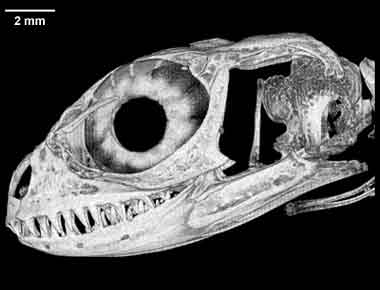|
|
Animations of the inner ear endocast and the braincase elements can be found under 'Additional Imagery' tab.
G. S. Bever, C. J. Bell, and J. A. Maisano. 2005. The Ossified Braincase and Cephalic Osteoderms of Shinisaurus crocodilurus (Squamata, Shinisauridae). Palaeontologia Electronica 8:4A:36p.
Department of Geological Sciences, Jackson School of Geosciences, The University of Texas at Austin, Austin, Texas 78712
gsbever@mail.utexas.edu, cjbell@mail.utexas.edu, maisano@mail.utexas.edu
ABSTRACT
We review the literature and provide a detailed description of the braincase, cephalic osteoderms, and the inner ear cavity of the rare southeast Asian lizard Shinisaurus crocodilurus. In addition to standard dry skeletal preparations, we used high-resolution X-ray computed tomography scans of an adult and juvenile specimen to provide novel illustrations and digital animations of the anatomical systems we studied. We provide the first detailed description and illustration of the orbitosphenoids, cephalic osteoderms, and inner ear passages in S. crocodilurus, clarify the presence or absence of previously reported anatomical features of the braincase, and provide preliminary observations on morphological change of the braincase through ontogeny. Orbitosphenoids are present and ossified in S. crocodilurus at a relatively early stage of postnatal development. A fully developed and ossified parasphenoid rostrum is present in our youngest dried specimen, but appears to be reduced or broken in many adult specimens. The osteoderms of adult S. crocodilurus are robust and widely distributed across the dorsal surface of the head, but they do not co-ossify with underlying dermal bones. They are absent in our juvenile specimens. Calcified endolymph is present in both adult and juvenile specimens, but is more extensive in the juvenile. Our preliminary observations suggest that ontogenetic change is an important source of variation in S. crocodilurus.

About the Species
This specimen, a newborn, originated from the pet trade. Its immature status is evident from the open parietal fontanelle and weak ossification of the braincase and scleral ossicles. It was made available to The University of Texas High-Resolution X-ray CT Facility for scanning by Dr. Chris Bell and Mr. Chris Jass of The University of Texas at Austin.

About this Specimen
The specimen was scanned by Matthew Colbert on 20-21 April 2000 along the coronal axis for a total of 516 slices, each slice 0.029 mm thick, with an interslice spacing of 0.029 mm. The dataset displayed was reduced for optimal Web delivery from the original, much higher-resolution CT data.

About the
Scan
Selected Literature
Baird, I. L. 1970. The anatomy of the reptilian ear. Pp. 193-275 in Biology of the Reptilia, volume 2, Morphology B (C. Gans and T. S. Parsons, eds.). Academic Press, New York.
Barrows, S., and H. M. Smith. 1947. The skeleton of the lizard Xenosaurus grandis (Gray). University of Kansas Science Bulletin 31:227-281.
Bellairs, A. d’A., and A. M. Kamal. 1981. The chondrocranium and the development of the skull in recent reptiles. Pp. 1-262 in Biology of the Reptilia, volume 11, Morphology F (C. Gans, and T. S. Parsons, eds.). Academic Press, New York.
Borsuk-Bialynicka, M. 1986. On the diagnosis of the Xenosauridae (Anguimorpha). Pp 213-218 in Studies in Herpetology: Proceedings of the European Herpetological Meeting (3rd Ordinary General Meeting of the Societas Europaea Herpetologica), Prague 1985 (Z. Rocek, ed.). Charles University, Prague.
Estes, R., and G. Pregill, eds. 1988. Phylogenetic relationships of the lizard families: essays commemorating Charles L. Camp. Stanford University Press, Stanford, California.
Hu, Q.-x., Y.-m. Jiang, and E.-m. Zhao. 1984. [A study on the taxonomic status of Shinisaurus crocodilurus]. Acta Herpetologica Sinica 3:1-7. [In Chinese].
Norell, M. A., and K.-q. Gao. 1997. Braincase and phylogenetic relationships of Estesia mongoliensis from the late Cretaceous of the Gobi Desert and the recognition of a new clade of lizards. American Museum Novitates 3211:1-25.
Oelrich, T. M. 1956. The anatomy of the head of Ctenosaura pectinata (Iguanidae). Miscellaneous Publications, Museum of Zoology, University of Michigan 94:1-122.
Rieppel, O. 1980. The phylogeny of anguinomorph lizards. Denkschriften der Schweizerischen Naturforschenden Gesellschaft 94:1-86.
Wu, C.-h., and Z.-j. Huang. 1986. [Morphological comparison of Shinisaurus crocodilurus and Xenosaurus grandis]. Sinozoologica 4:41-50. [In Chinese].
Zhang, S-d., and Y.-r. Cao. 1984. [The anatomy of Shinisaurus crocodilurus Ahl]. Chinese Wildlife (Harbin) 1984:22-27. [In Chinese].
Zhang, Y.-x. 1991. [Shinisaurus: the Chinese crocodilian lizard]. China Forestry Publishing House. 98 pp. [In Chinese].
Zhang, Y.-x., and Z.-j. Tang. 1985. [The biology of Shinisaurus crocodilurus]. Acta Herpetologica Sinica 4:337-340. [In Chinese].
Zhao, E.-m., K.-t. Zhao, K.-y. Zhao, et al. 1999. [Fauna Sinica, Reptilia Vol. 2: Squamata, Lacertilia]. Science Press, Beijing. [In Chinese].
Links
An article on Shinisaurus crocodilurus by Ernst Hofmann for Reptiles Magazine
Shinisaurus crocodilurus on the Sedgwick County Zoo website
Shinisaurus crocodilurus from EMBL-Heidelberg

Literature
& Links
Three-dimensional volumetric renderings of articulated braincase and isolated braincase elements. Movies are 2 mb or less.

Additional Imagery
 |
|




























